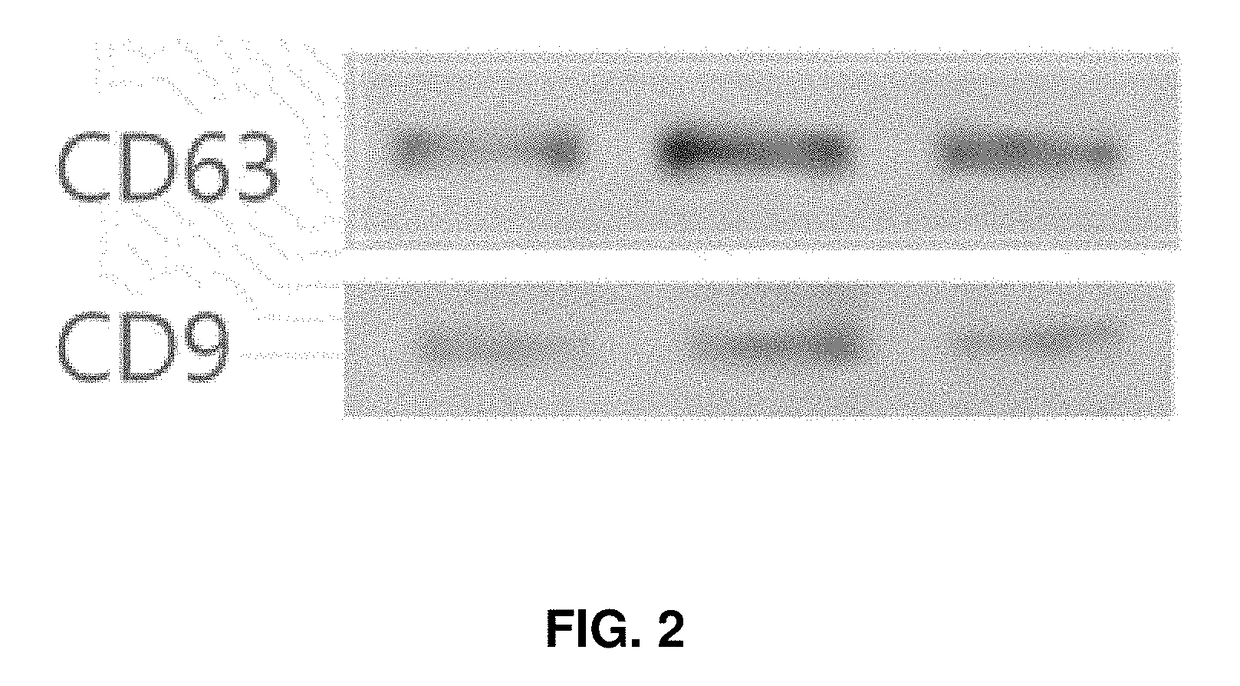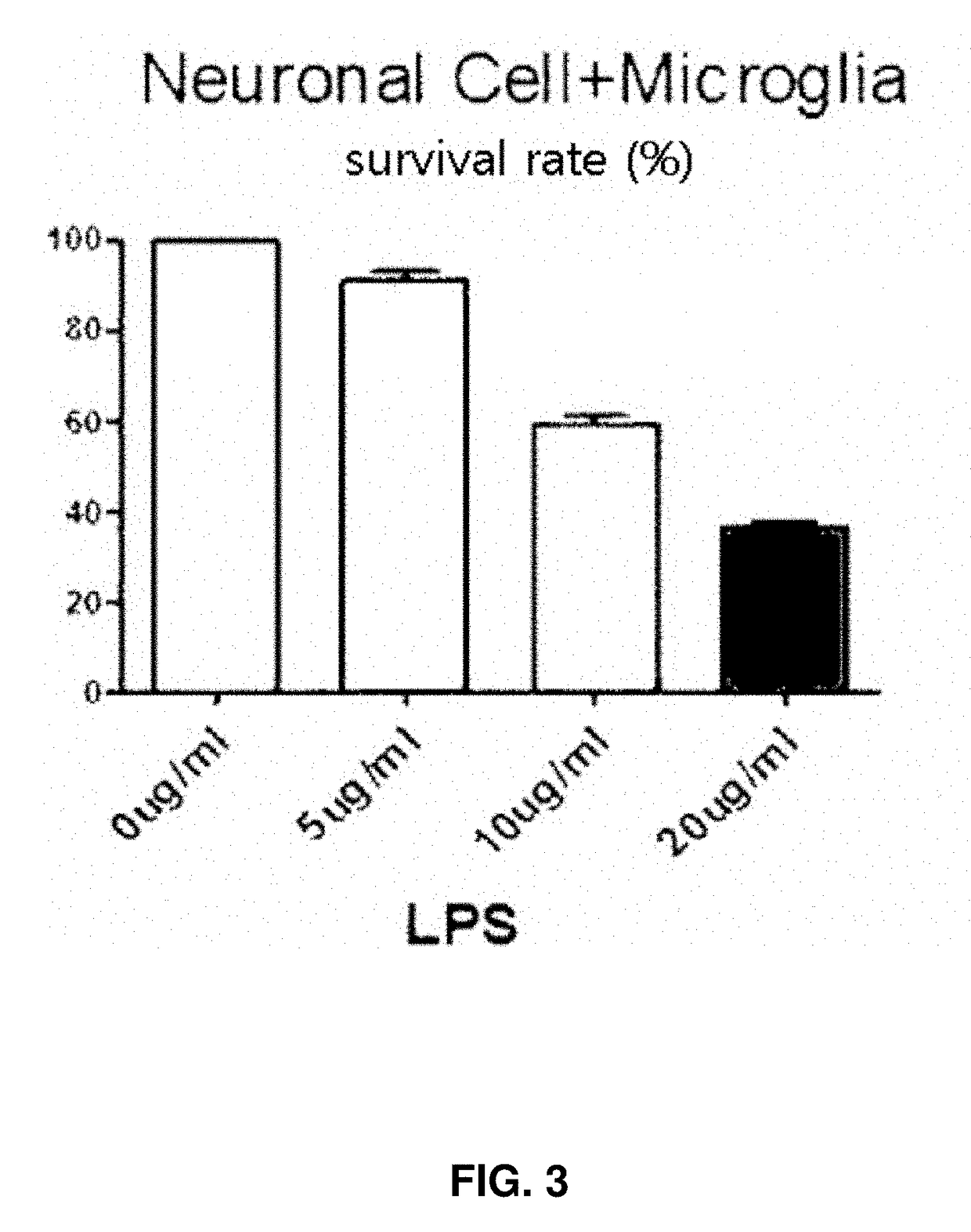Method for treating an inflammatory brain disease comprising administering a stem cell-derived exosome
a technology of exosomes and stem cells, applied in the direction of drug compositions, skeletal/connective tissue cells, genetic material ingredients, etc., can solve the problems of limited application of stem cell therapy, limited application to the human body, and limited application of cell therapy to clinical trials, so as to improve survival rate, inhibit cell death, and achieve outstanding therapeutic effects
- Summary
- Abstract
- Description
- Claims
- Application Information
AI Technical Summary
Benefits of technology
Problems solved by technology
Method used
Image
Examples
example 1
of Stem Cell-Derived Exosomes
[0045]To isolate stem cell-derived exosomes, an ultracentrifuge was used. More specifically, human umbilical cord blood-derived mesenchymal stem cells, diluted in culture media at a concentration of 1×105 cells / ml, were aliquoted into 60 mm culture dishes (3 ml / dish) and then cultured for one week. After confirming that the surface of the culture dish was entirely covered with the cultured stem cells, the culture medium thereof was replaced with a new culture medium containing thrombin at a concentration of 50 U / ml and then the stem cells were further cultured for 24 hours. After that, the culture medium was aliquoted into 2 ml centrifuge tubes and then centrifuged at 4° C. and 10000 g for 30 minutes, followed by removal of cell debris by transferring the supernatants to a new tube. The supernatants were again ultracentrifuged at 4° C. and 100,000 g for two hours, and the subsequent supernatants was removed to isolate exosomes (at a final concentration o...
example 2
Investigation into the Protective Effects of Stem Cell-Derived Exosomes on Nerve Cells
[0049]To investigate the protective effects of stem cell-derived exosomes, obtained according to Example 1, on nerve cells, the following experiments were performed.
[0050]First, rats were sacrificed at 18.5 days' gestation to obtain fetuses, and then the cerebral cortexes of the fetuses were isolated, followed by culture with primary glial cells and nerve cells for 7 days. Cell death was observed in the cells, which were treated with LPS (lipopolysaccharides) at different concentrations, as illustrated in the FIG. 3.
[0051]As illustrated in the FIG. 3, it was confirmed that about 40% of nerve cells die when exposed to LPS at a concentration of 10 μg / ml. Thereafter, the nerve cells treated with LPS at the concentration were used as a brain inflammatory cell model.
[0052]Next, the nerve cells, treated with LPS at the concentration of 10 μg / ml, were treated with 15 μg of the stem cell-derived exosomes, ...
example 3
nvestigation into the Therapeutic Effects of Stem Cell-Derived Exosomes on Inflammatory Brain Diseases
[0054]3-1. Design of Bacterial Infection-Induced Encephalomeningitis Animal Model
[0055]To generate a bacterial infection-induced encephalomeningitis animal model, newborn rats at 10 days after birth were subjected to inhalation anesthesia, and the right cerebral ventricles of the rats were slowly administered E. coli (Escherichia coli) (10 μl) of 1×103 CFU (colony forming unit) using a stereotaxic frame with 31 gauge syringe for 60 seconds, followed by administration of antibiotics (ampicillin, 200 mg / kg) every 12 hours for 2 days. To confirm the therapeutic effects of stem cell-derived exosomes according to the present invention on encephalomeningitis, the mesenchymal stem cell-derived exosomes (20 μg), obtained according to Example 1, were diluted with 10 μl PBS, and then the diluted exosomes were slowly administered into the right cerebral ventricles of the rats (MEN+MSC exosome)...
PUM
| Property | Measurement | Unit |
|---|---|---|
| diameter | aaaaa | aaaaa |
| diameters | aaaaa | aaaaa |
| concentration | aaaaa | aaaaa |
Abstract
Description
Claims
Application Information
 Login to View More
Login to View More - R&D
- Intellectual Property
- Life Sciences
- Materials
- Tech Scout
- Unparalleled Data Quality
- Higher Quality Content
- 60% Fewer Hallucinations
Browse by: Latest US Patents, China's latest patents, Technical Efficacy Thesaurus, Application Domain, Technology Topic, Popular Technical Reports.
© 2025 PatSnap. All rights reserved.Legal|Privacy policy|Modern Slavery Act Transparency Statement|Sitemap|About US| Contact US: help@patsnap.com



